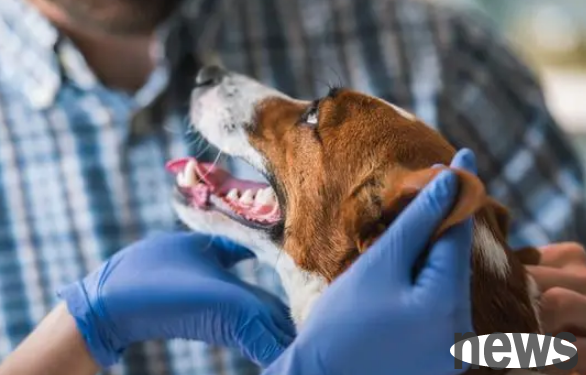1. What is dog kennel cough?
Canine kennel cough is caused by single or mixed infections such as viruses and bacteria. Canine kennel cough is a highly contagious respiratory disease with the characteristics of sudden attacks, sudden coughs, irregular spitting, eye and nose secretions.

Canine kennel cough, also known as trachea and bronchitis, is caused by infection of single or mixed pathogenic microorganisms such as viruses, bacteria, mycoplasma, etc. It is often found in puppies and is commonly found in dog farms. The reason why it is called "needle cough" is because if one of the dogs in a litter is infected with dog kennel cough, it will soon cause all the dogs in the litter to get infected and cough.
2. Clinical symptoms of dog kennel cough

The disease In the initial stage of dog disease, there was no obvious change in spirit and appetite, and only a short and thick dry cough appeared. The symptoms of cough worsened, and spastic dry cough appeared, which showed symptoms of tracheitis, followed by dry retching or vomiting to remove a small amount of mucus in the throat. The cough worsened during exercise, and it was particularly obvious at night.
As the disease develops, dogs with kennel cough will experience symptoms such as wind cough, asthma after exercise, and going up and downstairs. Sometimes, during the process of eating, dogs will also cough due to irritation to the trachea and throat.
Some sick dogs show paroxysmal inspiratory dyspnea, which can easily induce cough when pressing the throat or trachea. The body temperature is normal in the early stage. When secondary bacterial infection occurs, symptoms of body temperature rise and fever will appear in the later stage. The body temperature will gradually rise to between 39 and 40℃. Open the oral cavity to check for inflammatory reactions in the tonsils and pharynx; the number of respiratory frequency of visual diagnosis increases; the auscultation of respiratory sounds is enhanced, and verticular sounds appear in the lung area. Some dogs have mucous and purulent secretions in the nasal cavity.
If the dog has these symptoms, the owner should take the dog to the pet hospital for examination in time and treat it symptomatically after the diagnosis is confirmed.
3. Key points for treatment diagnosis

Only preliminary diagnosis can be made based on clinical symptoms. To be diagnosed, only bacterial isolation, culture, microscopy, virus isolation and serological examination can be carried out.
1. Diagnose based on medical history and typical clinical symptoms.
2. Bronchoscopy. It can be seen that the bronchial mucosa becomes congested, brittle, thickened, and a large amount of secretions and excretions in the bronchial. Take the tracheal cleaning solution and throat disease materials to separate, cultivate and identify pathogens.
3. X-ray examination. In dogs with severe infection, X-ray examination shows that the lesion's lung texture is thickened.
4. Pathological examination. It was found that inflammatory trachea exudation and increased mucus secretion, and the mucosa of the nasal cavity, larynx, and tracheal swelling, congested and inflamed. Pathological sections were performed, and the mucous glands in the submucosal layer were observed under the microscopic microscopic hyperplasia and hypertrophy, the mucous epithelial goblet cells increased, mucous plugs formed in the small and bronchioles, acinars atrophy, and pus cells were found in the bronchial lumen.
5. Agglutination experiment. The affected dogs were collected by blood, placed the blood samples in agglutination plates, and then added serum containing specific antibodies and observed in an electrolyte environment. After a period of time, the serum aggregates red blood cells into a clump that is visible to the naked eye, indicating that agglutination reaction has occurred and can be diagnosed as kennel cough.
Dog owners should regularly vaccinate dogs with rabies prevention vaccines in accordance with relevant national regulations, and should also prevent and treat other epidemics in dogs.
4. Can dog kennel cough heal itself?
Can dog kennel cough is adenovirus type 2, and the symptoms of canine kennel cough generally do not heal themselves.
Dog kennel cough is a highly infectious respiratory disease in dogs. It is caused by a variety of causes. The main infection is puppies in the whole litter. The clinical symptoms are viral respiratory infectious diseases characterized by high-frequency cough, dry retching, and runny nose.
If the test for positive cough in the dog kennel, it is necessary to use medicine in time. It can be cured through certain drug interventions, such as: broad-spectrum anti-inflammatory and antiviral treatment, symptomatic treatment for symptoms, cough and phlegm reduction, and injections for replenishing fluids.
It is impossible to heal the dog's kennel cough virus by relying solely on the resistance of the puppy. If the dog is older or has been immune to it, it can heal itself without complications.
5. Is there a mortality rate for dog kennel cough?
Under normal circumstances, dog kennel cough will not affect the life of a dog.
First, canine kennel cough refers to a respiratory disease caused by mycoplasma infection, and the dog itself can resist mycoplasma infection, but it only relies on dog immunity to achieve recovery time for a longer time.
Secondly, puppies (under 4 months of age) have a higher incidence rate. Puppies are most likely to be sick when they are just weaned. If the dog suffers from minor and other serious diseases during the infection of whole-little cough and does not intervene in time for treatment, then there is a possibility of death. Puppies often have a latency period of 5 to 10 days, and will generally die within 5-7 days.
Cannut kennel cough is not seasonal, but it occurs more in the cold season, and the main transmission path is air transmission.
6. Prevention and control measures

1. Do a good job in keeping dogs cold and warm.
2. Disinfect in a timely manner. First, use a gas blowtorch to disinfect the kennel, and then use bleach or caustic so as to achieve the purpose of killing excrement, urine, pus, nasal secretions and bacteria and viruses in the kennel and utensils within a few seconds.
3. Feed protein-rich foods to increase dog resistance.
Sick dogs should be isolated, healthy dogs should avoid contact with affected dogs. After the onset, all dogs are prohibited from scattering activities to block contact with the sick dog. Healthy dogs should be prevented by medication, and take oral tetracycline, compound isatis root tablets, cephalosporin and other drugs for prevention. At present, there is a canine kennel cough vaccine, which can have a better preventive effect.
The treatment of canine kennel cough requires both the symptoms and the root causes, and actively carry out anti-inflammatory and antiviral therapy to reduce secondary bacterial infections and kill pathogens.